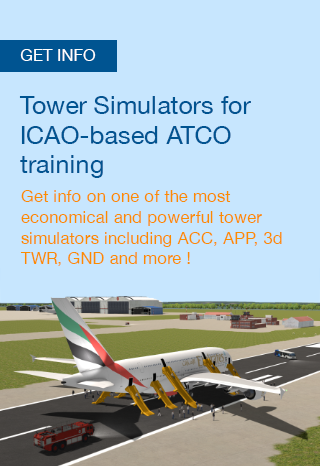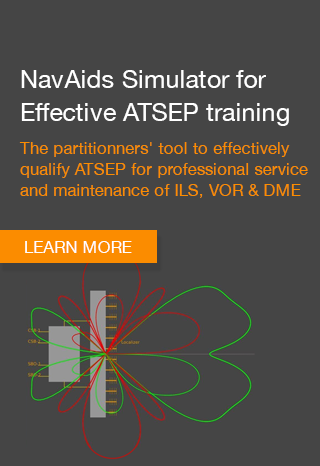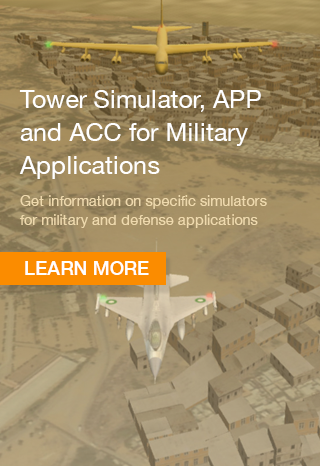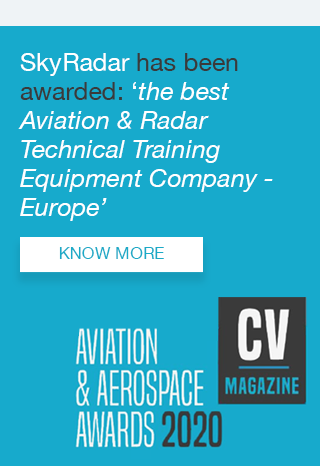Lots of things changed during the last 5 years with respect to operations, procedures and tasks. ATC training infrastructure needs to comply with ever changing applicable law, directives, regulations and pedagogical needs. But how to upgrade an existing Tower & Radar Simulator with limited budget?
ATC-training is always in the cross-fire of the need to innovate and the constraints of a restricted budget.
Drivers for renewal are:
 The infrastructure needs to comply with applicable national law and to follow the standards and directives of ICAO. It may be that operations, procedures or tasks change or that new ones need to be added (e.g., virtual control centers to remotely / flexibly manage distance airports or FIRs when needed)
The infrastructure needs to comply with applicable national law and to follow the standards and directives of ICAO. It may be that operations, procedures or tasks change or that new ones need to be added (e.g., virtual control centers to remotely / flexibly manage distance airports or FIRs when needed)- Pedagogical lessons learnt need to be included (e.g., improved learning results through modified learning paths)
- Sub-systems of the old simulator break or depreciate
- The ATCOs or ATSEPs get new tasks which are not part of the simulation yet (e.g., crossing runways, civil military cooperation, ADS-B, TIS-B, NOTAMS, ATIS etc.)
- More students need to be trained and the simulator's capacity is exhausted
- Technical innovation (computer hardware, projectors or screens, graphic cards, software for processing or visualization)
In most ATC training centers, upgrades are possible with limited paperwork and on short notice.
Most ATC-academies have a bigger scope of freedom when they upgrade, expand or repair a system, as compared to buying a new one.
Existing budget can be used up instead of requesting new dedicated investment budget. Expenditure can be split over several budgetary years, making it easier to stay within the given budget frame. Sometimes even tendering is not necessary, allowing to use "end-of-the-year budget".

Often existing simulators are not expandable at all or only with difficulties
There are many reasons why existing systems may not be expandable. Just to name some:
- During the last 5 - 10 years, many former developers of simulators disappeared from the market.
- The existing system manufacturer did not incorporate the innovations (as the continuous changes are costly and resource-intense)
But buying a new solution might be too costly or is not possible yet as the institute's regulations prescribe a longer system-life time before a new one can be purchased.
So what will be the silver bullet?
SkyRadar can upgrade and extend virtually all existing simulators

The complexity when upgrading an existing simulator depends on its conceptual quality.
Some of them follow
a) the data communication protocols by ICAO and Eurocontrol, such as ASTERIX
b) are conceived in an open architecture concept, avoiding vendor lock-in
In those cases it is relatively easy.
Others are rather monolithic systems, which do not follow the ICAO communication standards. Those systems rather remind on expensive video games and often provide only little value to the learners.
But also those monolithic systems provide open flanks for a step-by-step replacement.
Assess expandability and modular renewability
In a first step we need to check how open the existing software architecture is.
Can we expand it or even replace parts of it?
If yes, this is great news. But also the monoliths offer the scope of manoeuvre for a step-by-step upgrade.

The axes of expansion or replacement are
- expansion / replacement of system software modules or of the complete software
- expansion / replacement of hardware
- expansion / replacement of the Voice Communication System (VCS)
- expansion / replacement of Controller Working Positions, Supervisor Positions or Pseudo Pilots
- Appending of additional subsystem. E.g., a Tower Simulator can get ACC and APP or the other way round. Sometimes subsystems like Clearance Delivery (CLD) or Ground (GND) are missing
- expansion / replacement of consoles
- expansion / replacement of screens or projectors for 3D TWR simulation
- inclusion of live data (e.g., radar data, NOTAM, etc)
- connection of training radars
Finding the compromise between available budget and need for expansion and renewal
 Sometimes the replacement or expansion can be spread over several budgetary years. Costly components like consoles, screens and even graphic cards can be kept for another couple of months, even if that means that system beauty and image smoothness may not be optimal during that time.
Sometimes the replacement or expansion can be spread over several budgetary years. Costly components like consoles, screens and even graphic cards can be kept for another couple of months, even if that means that system beauty and image smoothness may not be optimal during that time.
But a defined system evolution plan can make sure that the training center progresses towards a professional system within a defined period of time and without compromise with regards to feature-set and regulatory compliance.
A frame contract with SkyRadar could even embed the upgrades into a service and maintenance contract (in many academies, service contracts are part of a separate budget "pot", which can be accessed in parallel to budget for upgrades or expansion).
Doing so, the academy will benefit from the bigger purchase discounts of the complete system.
Let us talk, we will find a way to enable evolution for your system even within limited budget frames. We do that every day ...




